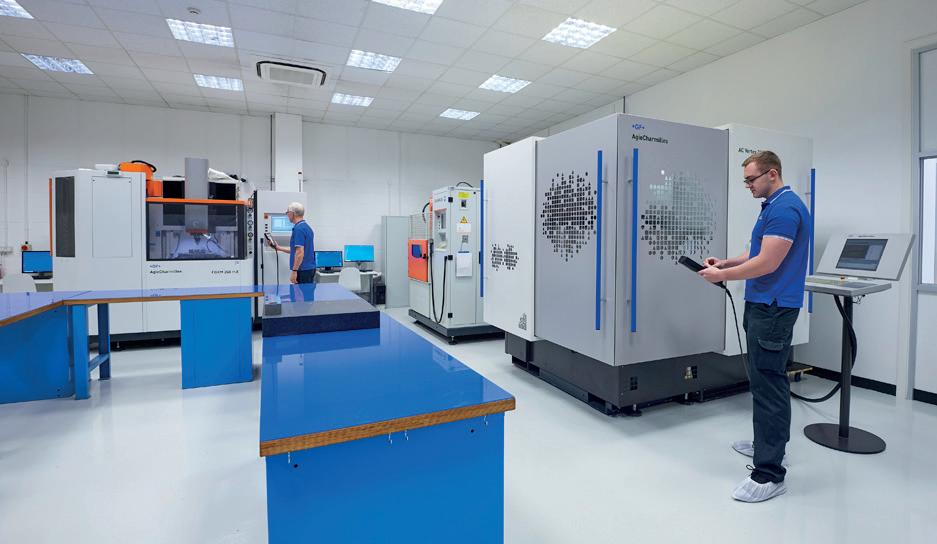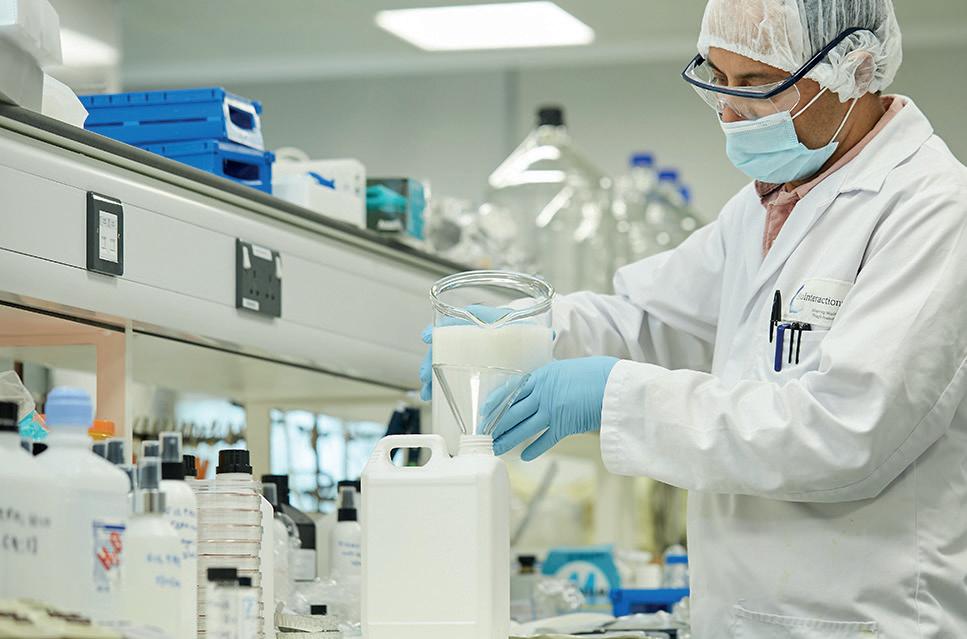
5 minute read
CONSIDERATIONS FOR DIAGNOSTIC COMP NENT DESIGN


Wayne Matthews, sales manager at Tecman Speciality Materials, comments on the UK diagnostics supply chain and designing with ease of supply in mind.

The UK diagnostic sector was put under the spotlight during the pandemic, and while the public attention given to PCR and lateral flow testing kits may have diminished, the sector is undergoing a quiet resurgence.
The 2021 Life Sciences Vision called for the development of new diagnostics to be accelerated following the hugely impactful role the sector played in COVID-19 testing. The pandemic focus has shifted but the sector continues to innovate, with diagnostic manufacturers working with specialists like Tecman to source and develop specific components for a huge variety of diagnostic tools that play a role in everything from viral testing kits to hygiene and sterilisation testing strips.
The diagnostics supply chain is strong, integrated and is growing because of an influx of international interest in the capabilities of those supporting this supply chain. But it is also complex, with lots of specialist manufacturers playing small but significant roles within it whether that be developing assays, adhesive components or plastics.
We produce a range of components for the life sciences and medical sector from diagnostic strips and microfluidics sealing tape, to self-adhesive disposable surgical items and body fluid absorption pads. In most cases these are supplied white label to our customers, who integrate them into existing product lines or launch new ones.






Developing components and solutions for the life science sector requires industry knowledge and the capabilities suitable for manufacturing at scale. Our engineers have expertise to draw on by working with some of the biggest names in healthcare, but crucially they also work on cross-sector projects that allow them to draw on diverse experience and bring new ideas into the mix.
Working with customers to develop these components begins with a fairly standard scoping of project requirements and some preliminary testing of existing solutions to determine how we as an engineering partner can best support with NPD, manufacturing and technical support.
Previous work includes a focus on sterilisation diagnostics, developing hydrogen peroxide testing strips, which we have been supplying for almost 10 years. These are vital in contamination management and infection control, particularly in a secondary care setting.
Adding value to the diagnostic component manufacturing process can mainly be done through a mix of capabilities and expertise. On the capability front, this can be based on an ability to carry out high volume manufacturing, or it could be based solely on offering a particular manufacturing process. We are fortunate in being able to combine these offerings to service a wide variety of life science businesses.
Life sciences customers are drawn to engineering and manufacturing capabilities. This has led us to working with customers to manufacture complex diecut adhesive components for well and sealing plates that are part of a Lipidic Cubic Phase (LCP) screening kit. These kits are a medium for crystalising membrane proteins – forming the crystals is usually slow and difficult so these kits are important, especially because of the role the proteins play in cellular interactions.








As we work cross-industry, we can secure a range of innovative materials for use in diagnostic component manufacturing through our international partnerships with the likes of tesa, 3M and Nitto.

The advantage of a growing UK diagnostics sector is that lead times are shorter, logistics and shipping emissions are lower and follow-on technical and customer support is much stronger than is the case in more fragmented supply chains. There is innovation happening across the life sciences sector, but it is in the diagnostics space that some of the most exciting product developments are taking place.
UK diagnostics has become so successful because manufacturers have innovated and delivered outstanding products. I’m proud of the role Tecman has played, and continues to play, in supporting them to do so.













































Broadly speaking, microfluidics involves the behaviour, manipulation, and control of fluids that are constrained within very small geometry, typically at the micrometre scale. In the medical industry, microfluidics has become an increasingly important tool for several applications.
One key advantage of microfluidics is the ability to handle very small amounts of biological material, such as blood or saliva. This can be especially useful for diagnostic testing to take small samples.
By enabling researchers and clinicians to handle and analyse small volumes of biological material with high precision and accuracy, microfluidics is helping to drive advances in diagnostics, drug discovery, and personalised medicine.
Within diagnostics, microfluidics is being widely used when developing pointof-care systems, which can be used to quickly detect diseases or conditions within a clinical setting. These devices can be designed to be portable, inexpensive per test, easy to use, and quick to result making them ideal for emergency situations.
It is an exciting and rapidly evolving field with tremendous potential to revolutionise the way we approach healthcare, receiving lots of attention from the media, academia, and venture capitalists. Although there are devices starting to penetrate the market, the realisation of these benefits may not yet be reflective of the money and effort being put in.


An obvious challenge which attracts much of the effort and attention during development is of the microfluidic device (or ‘chip’) itself. The interplay between fluid dynamics, surface chemistry, and microfabrication techniques, as well as understanding the underlying physics and chemistry makes for an attention absorbing technical hurdle. Also, the requirement for reliable, reproducible, and scalable results requires careful balancing and optimisation of efforts throughout the design and development process.
However, the microfluidic ‘chip’ is only a small part of the larger system and integrating these devices with other components and requirements can be challenging.
Here are some aspects of microfluidic systems that fall ‘outside the chip’ that shouldn’t be ignored:
System integration: In many cases, microfluidic systems must be integrated with external systems, such as pumps, valves, and sensors.
Interfaces: Fluid flow is driven by pressure gradients. Designing fluidic connections and interfaces that are clean, reliable, leak-free, and easy to use can be a significant engineering challenge.
Controls (sensing & feedback): To achieve closed-loop control over microfluidic systems, it is often necessary to incorporate sensors and feedback mechanisms. This can be challenging due to the small size of the system, which may require the development of specialised sensing technologies that can operate at the microscale.
Stability and robustness: Microfluidic systems can be sensitive to changes in environmental conditions, such as temperature, humidity, and vibration. Developing stable and robust systems requires careful design of components and materials, as well as advanced control algorithms.
Sample introduction: Introducing biological samples into microfluidic devices presents challenges such as sample preparation, handling, and storage; sample volume and concentration; contamination and crossreactivity; and assay development and validation. These challenges must be carefully managed to ensure that microfluidic devices produce reliable and accurate results.
User interface and user experience: In a clinical or research setting, microfluidic devices must be easy to use and intuitive for end users. Developing user interfaces that are clear, concise, and provide relevant feedback can be a significant design challenge.
Approval & adoption: Although there are reasons to be positive about the systems becoming more open and efficient, it’s justifiably slow moving and risk adverse. Make it easier for everyone involved by understanding your market and planning your approvals pathway from the start.
These are just some of the challenges involved and the complexity of this development landscape goes someway to explaining the gap between innovation and implementation of such devices in the field.
However, the potential benefits of microfluidics make the development journey a purposeful and impactful investment of time and energy so there is no doubt it’s the future. The question is how do we most efficiently and effectively bring such devices to market?
Strategy: Having a clear and well-communicated strategy is crucial to ensure that the device meets its intended application and requirements. It helps to identify the key challenges, resources, and milestones necessary for successful development. Remember that a strategy needs to be flexible and adaptable.
Collaboration: Bringing together experts from different disciplines with complementary skills and knowledge is essential as it enables the integration of diverse perspectives, which can lead to more creative and innovative solutions to complex challenges.
In any one device development very few of these challenges are being solved for the first time. If start-ups, multinationals, service providers, suppliers and industry can find ways to work together more efficiently and effectively, then efforts within the field of microfluidics become more likely to pay off.
Areas of Expertise












